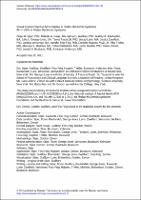Please use this identifier to cite or link to this item:
https://hdl.handle.net/20.500.12202/9429| Title: | Visual evoked potential abnormalities in Phelan-McDermid Syndrome |
| Authors: | Zemon, Vance Siper, Paige M. Rowe, Mikaela A. Guillory, Sylvia B. Rouhandeh, Audrey A. George-Jones, Julia L. Tavassoli, Teresa Lurie, Stacey Zweifach, Jessica Weissman, Jordana Foss-Feig, Jennifer Halpern, Danielle Trelles, M. Pilar Mulhern, Maureen S. Brittenham, Chloe Gordon, James Buxbaum, Joseph D. Kolevzon, Alexander 0000-0003-4048-6618 |
| Keywords: | Phelan-McDermid syndrome visual evoked potential (VEP) transient VEP autism spectrum disorder (ASD) |
| Issue Date: | 2021 |
| Publisher: | Elsevier |
| Citation: | Siper, P. M., Rowe, M. A., Guillory, S. B., Rouhandeh, A. A., GeorgeJones, J. L., Tavassoli, T., Lurie, S., Zweifach, J., Weissman, J., FossFeig, J., Halpern, D., Trelles, M. P., Mulhern, M. S., Brittenham, C., Gordon, J., Zemon, V., Buxbaum, J. D., & Kolevzon, A. (2021). Visual evoked potential abnormalities in Phelan-McDermid Syndrome. Journal of the American Academy of Child & Adolescent Psychiatry, 61(4), 565-574. https://doi.org/10.1016/j.jaac.2021.07.006 |
| Series/Report no.: | Journal of the American Academy of Child & Adolescent Psychiatry;61(4) |
| Abstract: | Objective: The current study used visual evoked potentials (VEPs) to examine excitatory and inhibitory postsynaptic activity in children with Phelan McDermid syndrome (PMS) and the association with genetic factors. PMS is caused by haploinsufficiency of SHANK3 on chromosome 22 and represents a common single-gene cause of autism spectrum disorder (ASD) and intellectual disability. Method: Transient VEPs were obtained from 175 children, including 31 with PMS, 79 with idiopathic ASD, 45 typically developing controls, and 20 unaffected siblings of children with PMS. Stimuli included standard and short-duration contrast-reversing checkerboard conditions, and the reliability between these 2 conditions was assessed. Test retest reliability and correlations with deletion size were explored in the group with PMS. Results: Children with PMS and, to a lesser extent, those with idiopathic ASD displayed significantly smaller amplitudes and decreased beta and gamma band activity relative to TD controls and PMS siblings. Across groups, high intraclass correlation coefficients were obtained between standard and short-duration conditions. In children with PMS, test retest reliability was strong. Deletion size was significantly correlated with P60-N75 amplitude for both conditions. Conclusion: Children with PMS displayed distinct transient VEP waveform abnormalities in both time and frequency domains that might reflect underlying glutamatergic deficits that were associated with deletion size. A similar response pattern was observed in a subset of children with idiopathic ASD. VEPs offer a noninvasive measure of excitatory and inhibitory neurotransmission that holds promise for stratification and surrogate endpoints in ongoing clinical trials in PMS and ASD. |
| Description: | Scholarly article / Open Access |
| URI: | https://www.sciencedirect.com/science/article/pii/S0890856721004743?via%3Dihub https://hdl.handle.net/20.500.12202/9429 |
| ISSN: | 0890-8567, 1527-5418. |
| Appears in Collections: | Ferkauf Graduate School of Psychology: Faculty Publications |
Files in This Item:
| File | Description | Size | Format | |
|---|---|---|---|---|
| Zemon 2021 OA Visual 1-s2.0-S0890856721004743-am.pdf | 475.08 kB | Adobe PDF |  View/Open |
This item is licensed under a Creative Commons License

